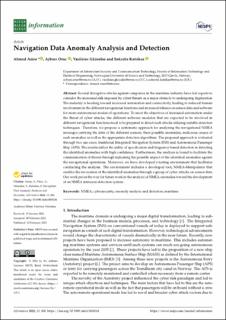| dc.contributor.author | Amro, Ahmed Walid | |
| dc.contributor.author | Oruc, Aybars | |
| dc.contributor.author | Gkioulos, Vasileios | |
| dc.contributor.author | Katsikas, Sokratis | |
| dc.date.accessioned | 2023-02-09T12:40:35Z | |
| dc.date.available | 2023-02-09T12:40:35Z | |
| dc.date.created | 2022-03-05T19:00:37Z | |
| dc.date.issued | 2022 | |
| dc.identifier.issn | 2078-2489 | |
| dc.identifier.uri | https://hdl.handle.net/11250/3049719 | |
| dc.description.abstract | Several disruptive attacks against companies in the maritime industry have led experts to consider the increased risk imposed by cyber threats as a major obstacle to undergoing digitization. The industry is heading toward increased automation and connectivity, leading to reduced human involvement in the different navigational functions and increased reliance on sensor data and software for more autonomous modes of operations. To meet the objectives of increased automation under the threat of cyber attacks, the different software modules that are expected to be involved in different navigational functions need to be prepared to detect such attacks utilizing suitable detection techniques. Therefore, we propose a systematic approach for analyzing the navigational NMEA messages carrying the data of the different sensors, their possible anomalies, malicious causes of such anomalies as well as the appropriate detection algorithms. The proposed approach is evaluated through two use cases, traditional Integrated Navigation System (INS) and Autonomous Passenger Ship (APS). The results reflect the utility of specification and frequency-based detection in detecting the identified anomalies with high confidence. Furthermore, the analysis is found to facilitate the communication of threats through indicating the possible impact of the identified anomalies against the navigational operations. Moreover, we have developed a testing environment that facilitates conducting the analysis. The environment includes a developed tool, NMEA-Manipulator that enables the invocation of the identified anomalies through a group of cyber attacks on sensor data. Our work paves the way for future work in the analysis of NMEA anomalies toward the development of an NMEA intrusion detection system. | en_US |
| dc.description.abstract | Navigation Data Anomaly Analysis and Detection | en_US |
| dc.language.iso | eng | en_US |
| dc.publisher | MDPI | en_US |
| dc.rights | Navngivelse 4.0 Internasjonal | * |
| dc.rights.uri | http://creativecommons.org/licenses/by/4.0/deed.no | * |
| dc.title | Navigation Data Anomaly Analysis and Detection | en_US |
| dc.title.alternative | Navigation Data Anomaly Analysis and Detection | en_US |
| dc.type | Peer reviewed | en_US |
| dc.type | Journal article | en_US |
| dc.description.version | publishedVersion | en_US |
| dc.source.volume | 13 | en_US |
| dc.source.journal | Information | en_US |
| dc.source.issue | 3 | en_US |
| dc.identifier.doi | 10.3390/info13030104 | |
| dc.identifier.cristin | 2007807 | |
| dc.relation.project | Norges forskningsråd: 295077 | en_US |
| dc.relation.project | Norges forskningsråd: 310105 | en_US |
| cristin.ispublished | true | |
| cristin.fulltext | original | |
| cristin.qualitycode | 1 | |

